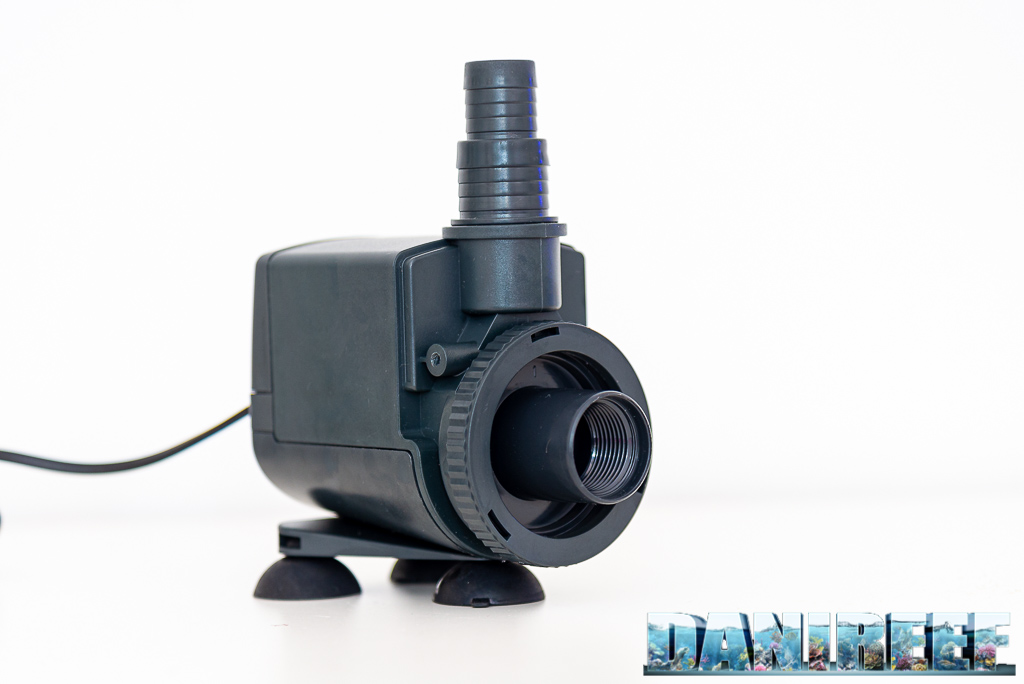
Today we have a NEWA product that has proven its worth: the Newa Jet 1700, known as NJ 1700.
I have always heard good things about NEWA Jet‘s return pumps, but I never had one before. The occasion presented itself when I had to choose the feed pump for my LGMAquari LGs900 skimmer, and my producer chose Newa as the perfect mate. So I purchased one, but I’m presenting it as a return pump, since this is the area in which it will work the most.
The pump is a non-adjustable alternating current centrifugal pump, but you can mechanically partialize the incoming flow. We measured, as usual, hydraulic head, flow rate, and power consumption.
To measure the hydraulic head we used our usual static method, for the flow rate we used the DigiFlow 6710M flowmeter, and for the power consumption we used the RCE PM600.
Technical characteristics of the Newa Jet 1700
| European version 230 V – 50 Hz | |
| Flow rate: | 600-1,700 l/h |
| Power consumption: | 33 watts |
| Head: | 2.1 meters |
| Length: | 6.95 cm |
| Depth: | 10.9 cm |
| Height: | 9.6 cm (just the body) |
| Price: | 43,49 euro |
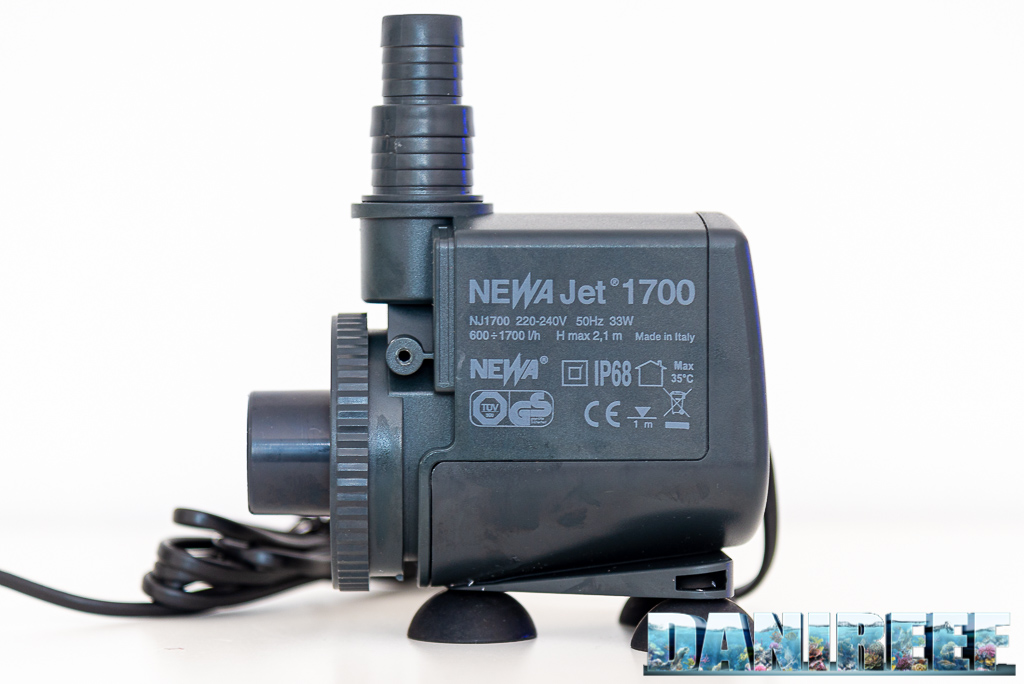
The new Newa Jet 1700 has, on paper, an energy efficiency of 51.5 liters for every watt consumed and economic efficiency of 39 liters per second per euro, so a baseline of 1,785 l*m/h.
And the price is relatively low. You can buy a very solid pump which allows even a small adjustment on the flow rate. The economic efficiency is pretty good, the technical one is average. Let’s see now how it behaved in our lab and how the results compare to other pumps that we have measured.
The construction
The design of the pump is simple and square-ish. It is classic grey with blue inserts and writing.
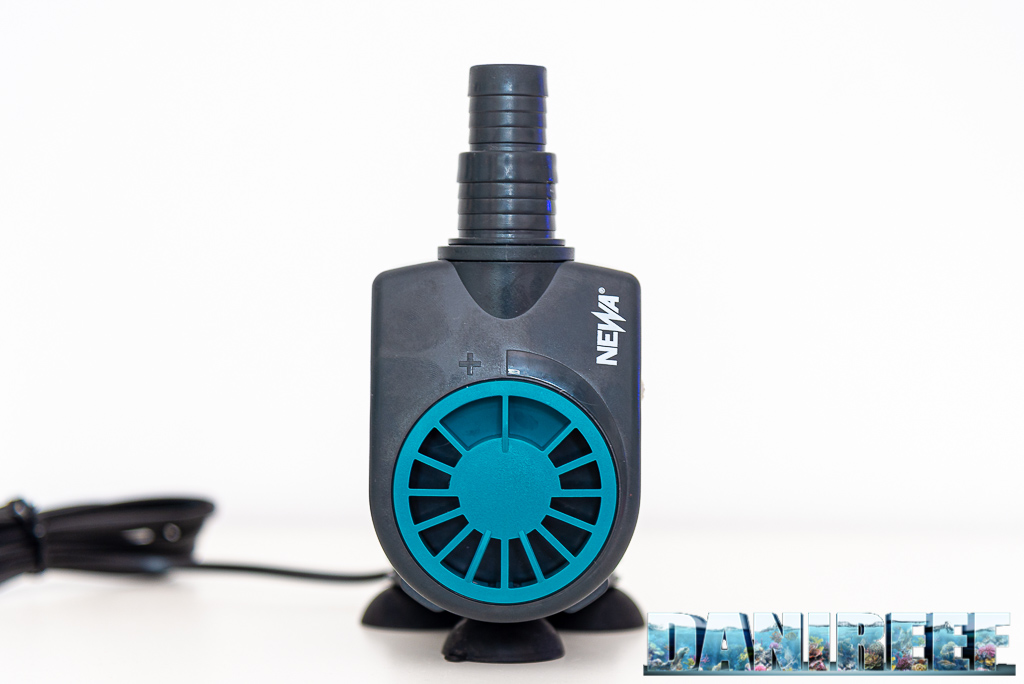
Inside the package there are the pumps and a couple of hose adaptors. They can be sized depending on the diameter of the return hose.
The pump has two shells: one, that you can see in the picture above, has the ring that partializes the incoming water, and the other, pictured below, draws water directly.

The rotor is the classic model with 6 straight blades and ceramic spindle. The sizes, given the low reference value, are quite contained.

Head test
The first test we did was the head. You already know it’s the pump’s capacity to elevate the water over a certain height. In order to this, we measured the level reached by the water inside a hose.

As you can see in this picture from our archive, we fix the hose to the terrace, then we turn on the pump we intend to test, we wait about 10 minutes to let it stabilize, then we measure the head.
So, the head we measured was 2 meters against the 2.1 meters declared.
The gap between the declared head and ours is under 5%. A perfect result, falls within the tolerances.
Rate test
Measuring the rate has been very easy thanks to the DigiSavant DIGIFLOW 6710M flow rate meter.
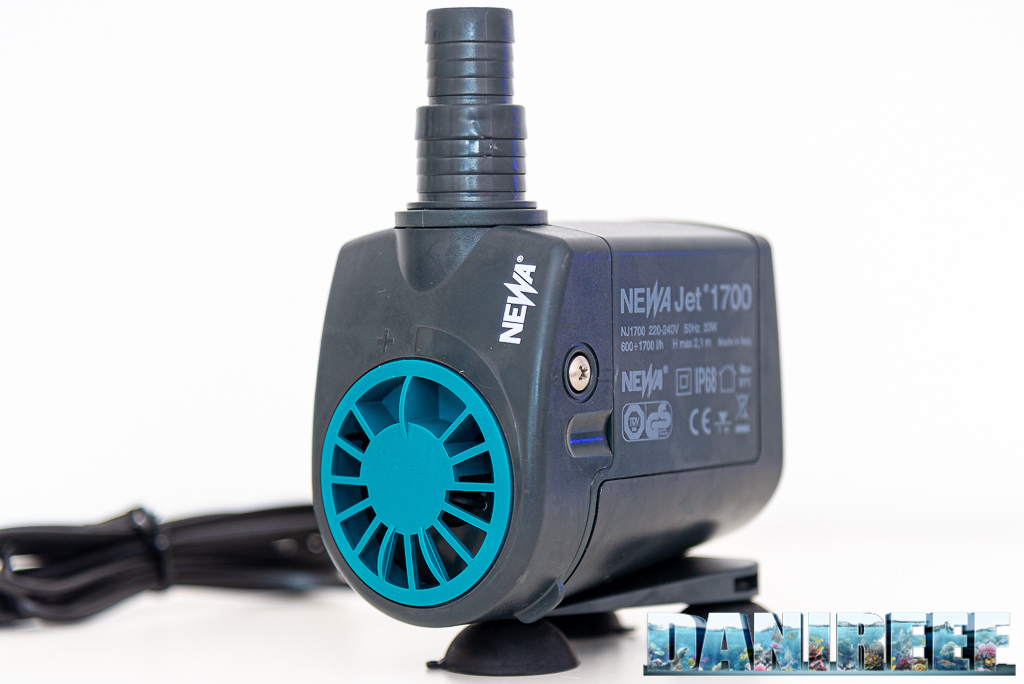
First, we connected the hoses to our flow rate meter. We tried to make the device adhere perfectly to the pump’s outlet.
The measure is expressed in liters per minute. So we only have to multiply the result by 60 to obtain the liters per hour.
Remember that the measurement is valid within the conditions in which we did the test. The hose as we used it could have led to some lacks.
But our system resulted in this value:

The maximum rate was 1,638 l/h (that is 27.3 l/m*60), which is very similar to the manufacturer’s declared 1,700 l/h. Something that happens very rarely! So the pump has reached 96.3% of the declared value in the conditions of the test. An excellent result if we consider the 66% of the Ecotech Marine Vectra M1, the 67% of the Waveline DC6000, the 70% of the Hydor Seltz D6000 and the 83% of the Rossmont RX 5000, just to name a few of the pumps we tested lately.
When you have to use a return pump, pay attention to the following aspects that can decrease, even drastically, the rate: use the biggest hose connector supplied; use a larger hose if you can; the hose has to be as short as possible, and it has to do as few 90° turns as possible. Otherwise the rate will be greatly penalized.
Power consumption test
The measure of the instant power consumption was possible thanks to the useful RCE PM600, that can also measure the Cos(fi) (or power factor). The result is already given in watts.
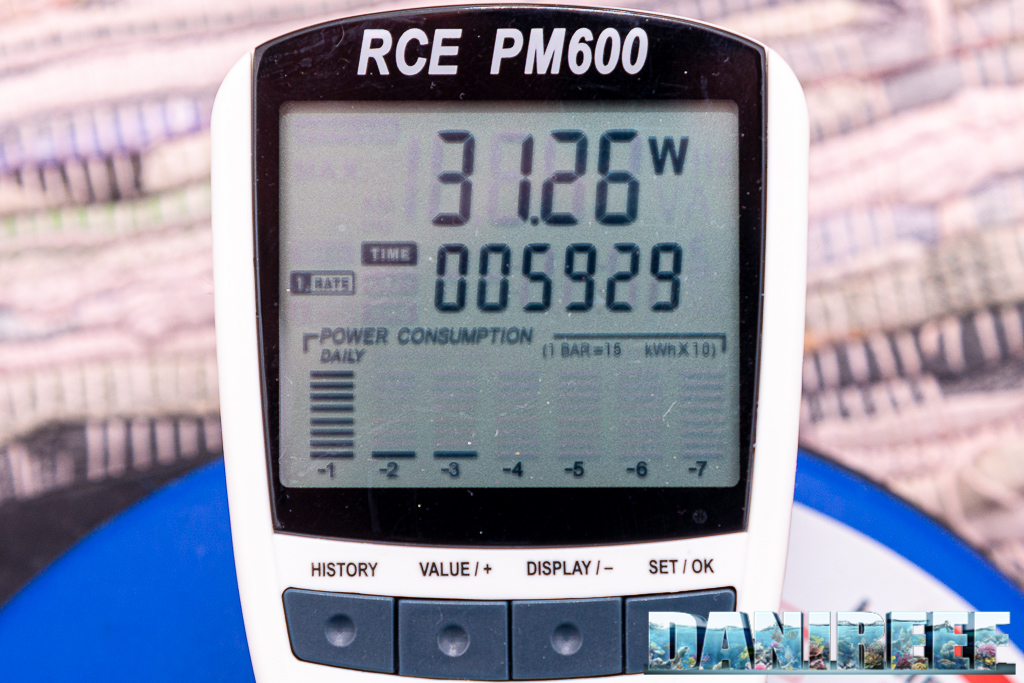
The maximum power consumption of the Newa Jet is 33 watts. According to our measurements, the true value is about 31.26 watt, practically 5% less than the declared value.
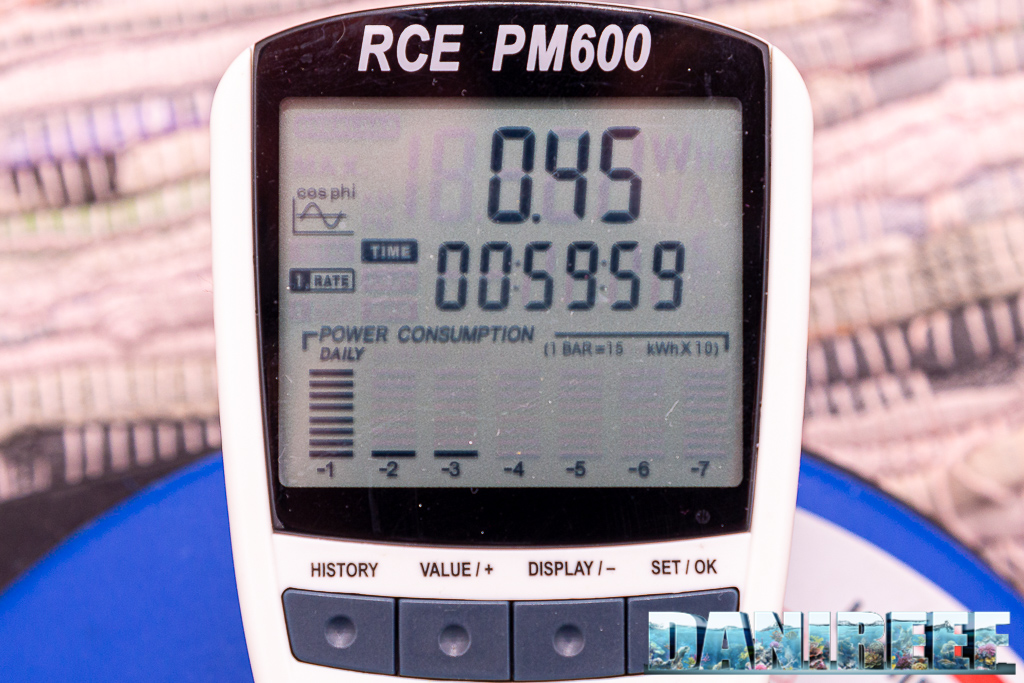
The Cos(fi) measured, that is the power factor, shows a value of 0.45, and practically speaking this means that this pump heats up a lot. Usually every pumps does that, and the Newa is no exception.
Considering a consumption of 31.26 watt, and an energy cost of 0,27 euro per kwh, we could use this pump continuously for a whole year with a power consumption of about 274 kwh, from which derives a cost of 74 euro per year, or 6 euro per month.
Given the size of the pump and, especially, its head value, we couldn’t do our usual noise test.
Our comment
After the great feedback from our friends we had very high expectations on this pump, and we weren’t disappointed! The pump keeps its promises and this rarely happens, especially in regards to the rate, that almost never matches the declared data. But this isn’t the case!
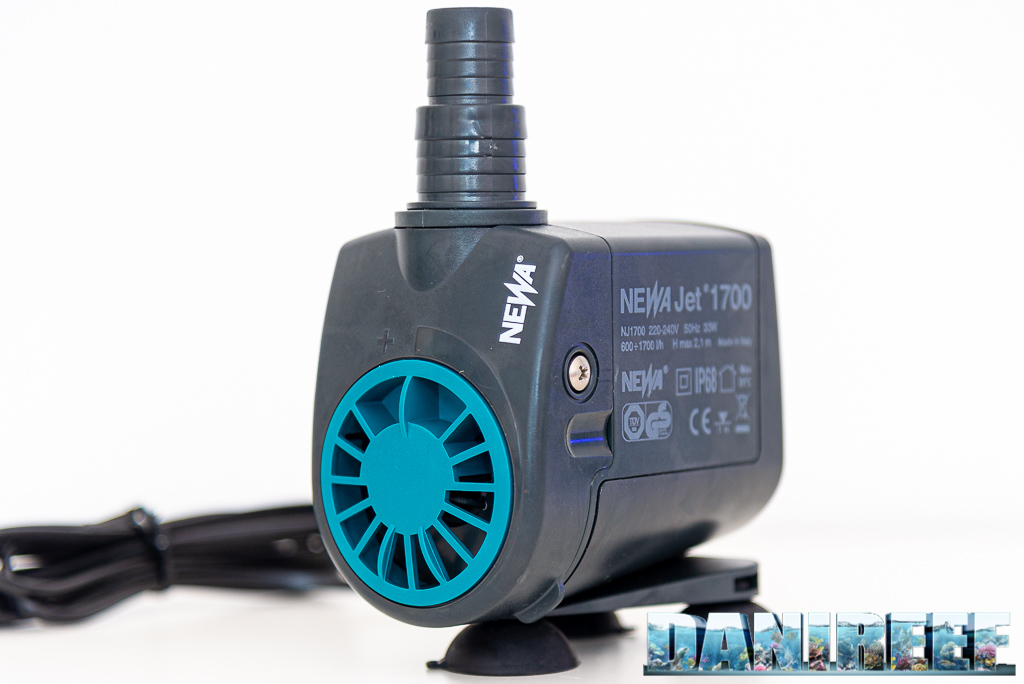
These conclusions will be really full of material since we’ll do a comparison with similar pumps we have tested before!
The comparison with other pumps
The comparison with the other pumps we’ve tested is very interesting. In particular, we’re comparing the data of Eheim, Hydor, Tunze, Sicce, Corallinea, Waveline and Ecotech Marine, all shown below in the chart. We ordered the chart basing on the reference value of the pump, that is the product of the flow rate times the head divided by 2. In this way we obtain the subtended area. We believe this is the only way to compare similar pumps. If the reference value differs too much we think they can’t be compared.
| Pomp | Head | Rate | Reference value | Power consumption | Price | Efficiency | Economic efficiency | Annual cost |
| Eheim 1250 | 195 cm | 1205 l/h | 1175 | 23.8 w | 98 € | 50.6 l/h*w | 12.3 l/h*€ | 56 € |
| Newa Jet 1700 | 200 cm | 1638 l/h | 1638 | 31.2 w | 43 € | 52.5 l/h*w | 38 l/h*€ | 74 € |
| Sicce Syncra 3 | 296 cm | 2375 l/h | 3515 | 42.3 w | 100 € | 56.1 l/h*w | 23.7 l/h*€ | 100 € |
| Rossmont Riser RX 3200 | 281 cm | 2766 l/h | 3886 | 53.7 w | 115 € | 51.5 l/h*w | 24 l/h*€ | 127 € |
| Eheim 1260 | 350 cm | 2434 l/h | 4260 | 62.1 w | 155 € | 32.2 l/h*w | 15.7 l/h*€ | 147 € |
| Tunze 1073.50 | 436 cm | 2143 l/h | 4672 | 38.8 w | 180 € | 55.2 l/h*w | 11.9 l/h*€ | 92 € |
| Sicce Syncra 4 | 380 cm | 3709 l/h | 7047 | 94 w | 160 € | 39.5 l/h*w | 23.2 l/h*€ | 222 € |
| Corallinea BQ5000 | 404 cm | 3504 l/h | 7078 | 83.2 w | 120 € | 42.1 l/h*w | 29.2 l/h*€ | 197 € |
| Rossmont Riser RX 5000 | 364 cm | 4128 l/h | 7513 | 83.7 w | 145 € | 49.3 l/h*w | 28.5 l/h*€ | 198 € |
| Waveline DC6000 | 392 cm | 4008 l/h | 7857 | 50.2 w | 283 € | 79.7 l/h*w | 14.1 l/h*€ | 119 € |
| Hydor Seltz D6000 | 450 cm | 4194 l/h | 9437 | 53 w | 125 € | 79.1 l/h*w | 33.5 l/h*€ | 125 € |
| Ecotech Marine Vectra M1 | 610 cm | 4944 l/h | 15080 | 89.5 w | 399 € | 55.1 l/h*w | 12.3 l/h*€ | 212 € |
You can see from the chart that economically speaking, that is the rate per euro, the Newa Jet 1700 is the best value with its 38 l/h per euro. In regards to the technical efficiency it’s in line with the average. So, if the couple of values you research match with this pump, as you can verify in our calculator, you’ve found what suits you.
If you want to know if this pump suits your needs, based on the head that you have in your aquarium, I suggest you to check out these articles:
The latter will show you the estimated flow rate basing on your own conditions.
Conclusions
The reference value of the Newa Jet 1700 is 1,638 l*m/h, where the declared reference value is 1,785. The gap is very little, about 8%. Remember that the reference value is the area subtended by the values of head and rate. The calculation is (head x rate)/2.
The loss of 13% actually represents a very great value given the fact that the other competitors do worse.
In order to use a pump in our aquarium we always have to consider what it actually express, and not what it should. But in this case the values are practically identical. An incredible feature!
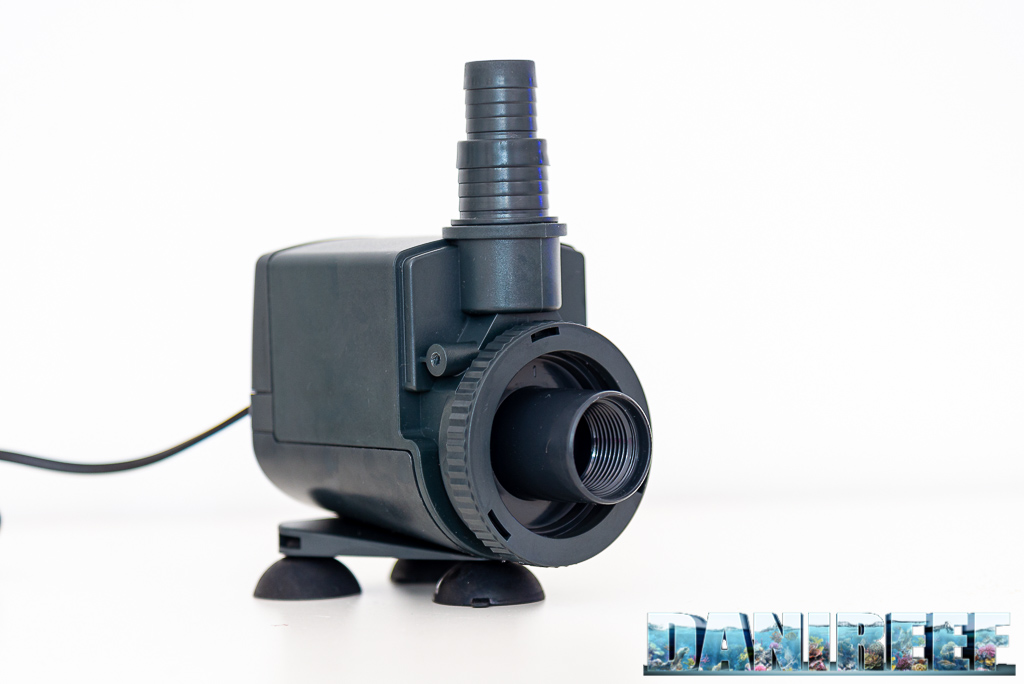
Disclaimer: Thanks to NEWA Tecno Industria srl for providing us with the Newa Jet 1700 pump for this review.
[translated by Agnese Poggi]










0 Comments